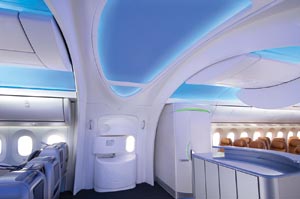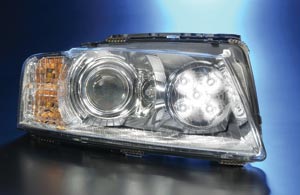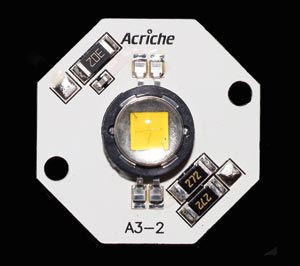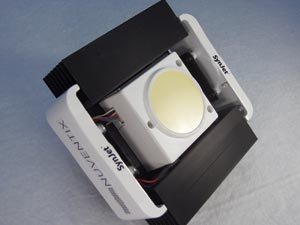Going toward the light
Dr. Christine Connolly, UK Correspondent
The fifth annual EuroLED conference held in West Midlands, UK, in June was a study in global networking — entertaining organizations and attendees with everything new about LEDs. Organizer Aston Science Park of Birmingham, also in the UK, proved once again that this signature conference on semiconductor lighting has become pivotal in defining and describing the maturity of the technology. LEDs surely are on the fast track. Benefiting from developments in thermal management, LEDs have grown from small indicator lights to powerful illumination sources, with possibilities one can only imagine — decorative lighting, for one, along with signs and displays, architectural and household lighting, and even automotive and aerospace applications.

This simulation of the Boeing 787 Dreamliner shows how arrays of LEDs create a skylike cabin ceiling. The flight crew controls the brightness and colour of the “sky” to give passengers a sense of daylight or of a nighttime sky. Courtesy of The Boeing Company.
Word from the learned
Weighing in on research, the Engineering and Physical Sciences Research Council, the UK’s main research-funding body for this area of technology, presented state-of-the-art developments under way at several universities.
The universities of Strathclyde, Sheffield and Heriot-Watt, and Imperial College London are wrapping up an extensive project on microstructured LEDs, which are less expensive and more compact than a laser. These miniature light sources enable scanning microscopy with no moving parts and have applications in labs-on-a-chip, microfluidics and retinal prosthetics.
Cambridge and Manchester Universities are delving into the materials science of gallium nitride (GaN) to improve quantum efficiency, lifetime and cost, thus accelerating the use of LEDs in home and office lighting. Nottingham University recently patented a process for growing cubic-crystal GaN layers, which opens potential applications in electronic and optoelectronic devices. And the University of Bath is looking into new LEDs for efficient lighting systems and has advanced nanofabrication resources such as electron beam lithography and inductively coupled plasma etching.
Prof. Jack Silver of Brunel University in London described work on developing phosphors to convert the colour output of LEDs, the emissions from which miss the peak sensitivity wavelengths of the human eye. The researchers dope a very pure inorganic host lattice with activators such as gold, copper or rare-earth elements and now are experimenting with new material phosphors such as metal nitrides.
Not to be overlooked are quantum dots, which present another colour-conversion technique. Nanoco Technologies Ltd. uses the quantum dot size to control the colour, producing tunable, bright and long-life emissions.
What’s up and what’s not
Tending to the market news, Robert Steele of Strategies Unlimited presented a summary titled “High-Brightness LED Market Overview and Forecast,” in which he suggested that mobile device applications had reached their peak in 2004. Most notebook computer manufacturers, he pointed out, use white LEDs for display backlighting because of their slim profile and battery-saving efficiency.

The five white LEDs in the headlights of the Audi A8 W12 provide the daytime running lights that are compulsory in Scandinavian countries, along with dimmed nighttime position lighting. Courtesy of Hella KGaA Hueck & Co.
Instead of mobile devices, signs, displays and general illumination made up the largest growth segments during 2007, he said, and illumination is forecast to become the largest-growing sector. Emerging markets include car headlights, backlighting of LCD televisions and solid-state lighting.
Lexus, Cadillac and Audi are rolling out vehicles with LED headlights in 2008, and that’s good news for designers seeking innovative style. Samsung is currently the leader in LED-backlit televisions, which are still young in development, although their prospective market is huge.
Solid-state lighting is attracting a number of business start-ups and the venture capital investment to go with them. The best luminaires now achieve 60 lm/W efficiency, and even if their current quality is highly variable, standards are now in the development stage. For example, Energy Star of Washington has finalized a new specification for solid-state lighting luminaires that goes into effect September 2008. It covers their uses in residential, commercial, industrial and outdoor lighting, as well as in innovative systems incorporated into furniture, buildings and equipment.
David McAuley of Sustainable Energy Ireland — a government-funded agency responsible for promoting and assisting in the development of sustainable energy — reported that the Irish government is introducing in January an energy-efficiency standard for lighting. He is pressing the LED industry to develop a common reference manual for manufacturers, architects and retailers, to assist in penetrating the lighting supply chain.
Peter Lees of Recolight Ltd., a recycling company, said that, in a market further driven by pressure on governments to reduce greenhouse gas emissions, the 30,000-h lifetime and increasing efficiency and brightness of LEDs make them attractive as lighting sources. And although LEDs are not specifically mentioned in the WEEE regulations (Guidance on the Waste Electrical and Electronic Equipment), which came into force in July 2007, LEDs present a low hazard, Lees said, so Recolight is treating them as “household luminaries.”
Plenty to show for products
The solid-state lighting theme was in full swing on the exhibition floor, and one of the products on display offering the most convenience was the Acriche from Seoul Semiconductor Inc. This room-lighting LED source plugs directly into the AC mains supply. Its integrated heat sink supplies passive cooling, it needs no driver circuitry, and it operates for 35,000 hours with a reduction to 70 per cent output.

The Acriche Z-power P7 series from Seoul Semiconductor Inc. can replace an ordinary lightbulb with its 900 lumens emitted from 10-W input.
Nuventix Inc. exhibited its SynJet technology, in which a 50-kHz vibrating rubber membrane pumps air silently. Originally used to replace cooling fans in computers, the system enables a two- to threefold increase in power density in LEDs.
Darren Spencer of Diamond Electronics Ltd. said that, although LEDs are not yet powerful enough to light large areas, they could be within the next two years. His company distributes LEDs for decorative underwater and wall-wash lighting as well as for vending machines in pubs and clubs. Currently, his biggest LED market in the UK is for shelf lighting.
BFi Optilas International SAS demonstrated light-shaping diffusers that enable the light from an LED to spread into a much more uniform distribution. With transmissions from 85 to 92 per cent, these diffusers provide much higher efficiency compared with traditional luminaire diffusers. In another section of the exhibition, Ocean Optics Inc. showcased its Brontes colorimeter, which makes 5500 colour measurements per second on LEDs, LCDs and plasma screens in the production environment.

This active-cooling module, based on SynJet technology, silently cools Philips’ Fortimo LED downlight. Courtesy of Nuventix Inc.
Microchip Technology Inc. exhibited controllers that change the power and colour of LED systems for ambient lighting. The company demonstrated in-car lighting controlled through the local interconnect network, which is the standard electronic control bus in cars. There is currently a big market in aircraft ambient lighting: Look for Boeing’s Dreamliner aircraft, which will have LED-based passenger mood lighting.
Elsewhere, the presence of UK Trade and Investment, the government agency for overseas companies wishing to trade with or invest in the UK, signalled the international nature of EuroLED and its role in building global LED markets. The agency also worked with a delegation from Chongqing, China, to facilitate meetings between UK and Chinese companies to generate commercial business in the field of LED lighting.